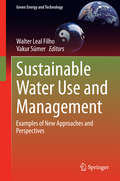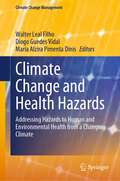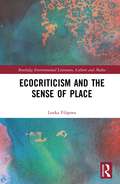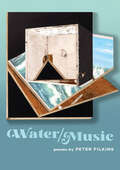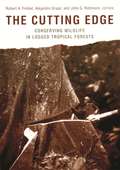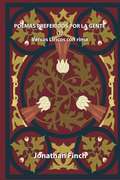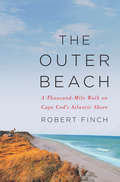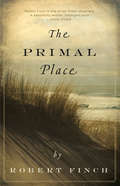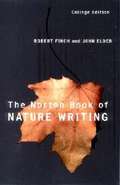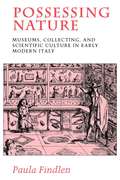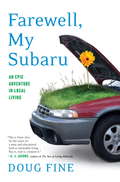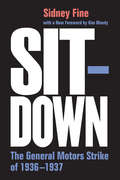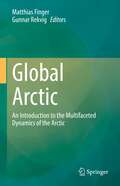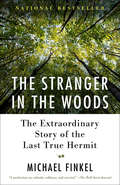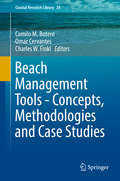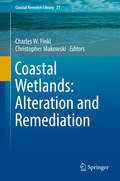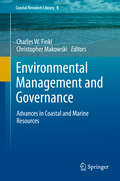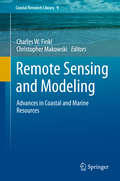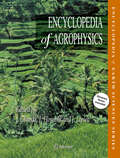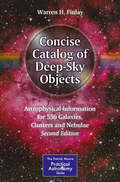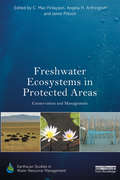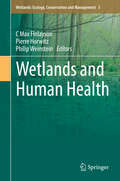- Table View
- List View
Sustainable Water Use and Management
by Walter Leal Filho Vakur SümerContributing to the growing debate on the need for sustainable water use and management, with concrete examples of new approaches, concepts, arguments, methods and findings which illustrate how this can be achieved, this book will be attractive for large groups of readers familiar with one or more of the themes it tackles, and to the general public. Within this context, the book makes use of many tables and graphics, which bring the many messages together. This approach is intended not only for those working on water matters (e. g. bureaucrats, water managers, policymakers, journalists, etc. ) and interested in water management issues and sustainability at large, but also for students of water management, water politics, environmental policy, water economics, water engineering and sustainability studies. Located at the crossroads of two key phenomena: sustainability and water, this book brings forward academic research and discussions on water efficiency, new technologies, and the water-agriculture nexus. It also benefits readers by tackling matters related to trans-boundary cooperation on water (including rainwater) and river-basin management, pricing issues, participatory water management, and the role of women in sustainable water use, amongst others.
Climate Change and Health Hazards: Addressing Hazards to Human and Environmental Health from a Changing Climate (Climate Change Management)
by Walter Leal Filho Diogo Guedes Vidal Maria Alzira Pimenta DinisThis book contains a set of papers which explore the links among climate change, health, and hazards and demonstrate how they interact. It emphasizes the urgency of immediate and more ambitious action to address climate risks. According to the Intergovernmental Panel on Climate Change (IPCC), human-induced climate change is known to be causing dangerous and widespread disruptions in nature and is affecting the lives of billions of people around the world, despite efforts to reduce the risks. Climate change is also negatively influencing health and is mounting threat to our wellbeing and a healthy planet. The world is also facing significant climate hazards over the next two decades, with global warming expected to soon reach 1.5°C. Even temporarily exceeding this warming level will result in additional severe impacts, some of which may be irreversible. There is therefore a perceived need for publications which may foster a greater understanding of how climate change connects to human health and the role played by hazards in this context. It is against this background that this book is being prepared.
Ecocriticism and the Sense of Place (Routledge Environmental Literature, Culture and Media)
by Lenka FilipovaThe book is an investigation into the ways in which ideas of place are negotiated, contested and refigured in environmental writing at the turn of the twenty-first century. It focuses on the notion of place as a way of interrogating the socio-political and environmental pressures that have been seen as negatively affecting our environments since the advent of modernity, as well as the solutions that have been given as an antidote to those pressures. Examining a selection of literary representations of place from across the globe, the book illuminates the multilayered and polyvocal ways in which literary works render local and global ecological relations of places. In this way, it problematises more traditional environmentalism and its somewhat essentialised idea of place by intersecting the largely Western discourse of environmental studies with postcolonial and Indigenous studies, thus considering the ways in which forms of emplacement can occur within displacement and dispossession, especially within societies that are dealing with the legacies of colonialism, neocolonial exploitation or international pressure to conform. As such, the work foregrounds the singular processes in which different local/global communities recognise themselves in their diverse approaches to the environment, and gestures towards an environmental politics that is based on an epistemology of contact, connection and difference, and as one, moreover, that recognises its own epistemological limits. This book will appeal to researchers working in the fields of environmental humanities, postcolonial studies, Indigenous studies and comparative literature.
Water / Music (Johns Hopkins: Poetry and Fiction)
by Peter FilkinsA diverse display of formal dexterity, narrative power, and lyrical resonance, Peter Filkins's latest collection of poems explores the fraught relationship between the natural world and the human.Exploring the space between nature and culture, the poems of Water / Music anchor themselves in the timely and the timeless. Rich and diverse in their formal intricacy, they move with ease from narrative to meditation, from close physical observation to the haunts of memory, and from lyric sorrow to the pleasure of living in the world. Water / Music embraces and celebrates life's mystery and the soul's repose amid "talismans at twilight, the whir of birds."
The Cutting Edge: Conserving Wildlife in Logged Tropical Forests (Biology and Resource Management Series)
by Fimbel Robert A. John G. Robinson Alejandro Grajal Eds.Recent decades have seen unprecedented growth in the scale and intensity of industrial forestry. Directly and indirectly, it has degraded the wildlife and ecological integrity of these tropical forests, prompting a need to evaluate the impact of current forest management practices and reconsider how best to preserve the integrity of the biosphere.Synthesizing the body of knowledge of leading scientists and professionals in tropical forest ecology and management, this book's thirty chapters examine in detail the interplay between timber harvesting and wildlife, from hunted and protected habitats to invertebrates and large mammal species.Collectively, the contributors suggest that better management is pivotal to the maintenance of the tropics' valuable biodiversity, arguing that we must realize that tropical forests harbor the majority (perhaps 70 to 80 percent) of the world's animal species. Further, they suggest modifications to existing practices that can ensure a better future for our valuable resources.
Will China Save The Planet?
by Barbara FinamoreNow that Trump has turned the United States into a global climate outcast, will China take the lead in saving our planet from environmental catastrophe? Many signs point to yes. China, the world's largest carbon emitter, is leading a global clean energy revolution, phasing out coal consumption and leading the development of a global system of green finance. <p><p> But as leading China environmental expert Barbara Finamore explains, it is anything but easy. The fundamental economic and political challenges that China faces in addressing its domestic environmental crisis threaten to derail its low-carbon energy transition. Yet there is reason for hope. China's leaders understand that transforming the world's second largest economy from one dependent on highly polluting heavy industry to one focused on clean energy, services and innovation is essential, not only to the future of the planet, but to China's own prosperity.
Poemas preferidos por la gente: Versos líricos con rima
by Jonathan FinchUna colección de poemas convencionalmente publicados en antologías, folletos y pequeñas revistas, muchos de los cuales recibieron un elogio especial.
The Outer Beach: A Thousand-mile Walk On Cape Cods Atlantic Shore
by Robert FinchA poignant, candid chronicle of a beloved nature writer’s fifty-year relationship with an iconic American landscape. Those who have encountered Cape Cod—or merely dipped into an account of its rich history—know that it is a singular place. Robert Finch writes of its beaches: “No other place I know sears the heart with such a constant juxtaposition of pleasure and pain, of beauty being born and destroyed in the same moment.” And nowhere within its borders is this truth more vivid and dramatic than along the forty miles of Atlantic coast—what Finch has always known as the Outer Beach. The essays here represent nearly fifty years and a cumulative thousand miles of walking along the storied edge of the Cape’s legendary arm. Finch considers evidence of nature’s fury: shipwrecks, beached whales, towering natural edifices, ferocious seaside blizzards. And he ponders everyday human interactions conducted in its environment with equal curiosity, wit, and insight: taking a weeks-old puppy for his first beach walk; engaging in a nocturnal dance with one of the Cape’s fabled lighthouses; stumbling, unexpectedly, upon nude sunbathers; or even encountering out-of-towners hoping an Uber will fetch them from the other side of a remote dune field. Throughout these essays, Finch pays tribute to the Outer Beach’s impressive literary legacy, meditates on its often-tragic history, and explores the strange, mutable nature of time near the ocean. But lurking behind every experience and observation—both pivotal and quotidian—is the essential question that the beach beckons every one of its pilgrims to confront: How do we accept our brief existence here, caught between overwhelming beauty and merciless indifference? Finch’s affable voice, attentive eye, and stirring prose will be cherished by the Cape’s staunch lifers and erstwhile visitors alike, and strike a resounding chord with anyone who has been left breathless by the majestic, unrelenting beauty of the shore.
The Primal Place
by Robert FinchFrom acclaimed author and naturalist Robert Finch, a richly detailed observance of Cape Cod's seemingly vanished natural and human past, as it clings to its present landscape. This is a voyage of discovery, a personal odyssey into the nature of a single Cape Cod neighborhood. It is a rich portrait, beautifully drawn, of a landscape and a community whose essential character lies in their penetrating interface with the sea. But it is also an individual quest, a journey of the heart and mind in which the author seeks "entrance, or rather re-entrance" into "that vast living maze stretching out beyond my lines of sight."
The Norton Book of Nature Writing, College Edition
by Robert Finch John ElderThe Norton Book of Nature Writing, College Edition offers, for the first time, a paperback edition of this ground-breaking anthology. In addition to its significantly expanded table of contents, the new version has been augmented by a Field Guide for teachers and students, written by Lilace Mellin Guignard, a writer and teacher at the Center for Environmental Literature of the University of Nevada at Reno. The Field Guide includes a thematic table of contents with useful groupings of the readings and a set of three study questions for each selection. These questions call attention to literary techniques and themes, suggest connections among various authors in the collection, and invite response to the personal or political challenges posed by particular selections. For students, these questions may offer a further context for their initial encounters with these readings and help to identify rich areas to explore further in their own writing. For teachers, they may serve as prompts for student journals or as topics for discussion in class.
Possessing Nature: Museums, Collecting and Scientific Culture in Early Modern Italy
by Paula FindlenIn 1500 few Europeans regarded nature as a subject worthy of inquiry. Yet fifty years later the first museums of natural history had appeared in Italy, dedicated to the marvels of nature. Italian patricians, their curiosity fueled by new voyages of exploration and the humanist rediscovery of nature, created vast collections as a means of knowing the world and used this knowledge to their greater glory. Drawing on extensive archives of visitors' books, letters, travel journals, memoirs, and pleas for patronage, Paula Findlen reconstructs the lost social world of Renaissance and Baroque museums. She follows the new study of natural history as it moved out of the universities and into sixteenth- and seventeenth-century scientific societies, religious orders, and princely courts. Findlen argues convincingly that natural history as a discipline blurred the border between the ancients and the moderns, between collecting in order to recover ancient wisdom and the development of new textual and experimental scholarship. Her vivid account reveals how the scientific revolution grew from the constant mediation between the old forms of knowledge and the new.
Farewell, My Subaru
by Doug FineA journalist who contributes to National Public Radio recounts hardwon lessons he learned from trying to live a more sustainable lifestyle "with a minimum of hypocrisy. " Among Fine's mis/adventures on his Funky Butte ranch are: converting a truck to run on restaurant waste oil, defending his goats from predators, and installing solar panels. He agrees with Kermit the frog that being green isn't easy but remains committed. The book includes facts about our carbon footprint, Web resources, and several recipes.
Hemp Bound
by Doug FineThe stat sheet on hemp sounds almost too good to be true: its fibers are among the planet's strongest, its seed oil the most nutritious, and its potential as an energy source vast and untapped. Its one downside? For nearly a century, it's been illegal to grow industrial cannabis in the United States-even though Betsy Ross wove the nation's first flag out of hemp fabric, Thomas Jefferson composed the Declaration of Independence on it, and colonists could pay their taxes with it. But as the prohibition on hemp's psychoactive cousin winds down, one of humanity's longest-utilized plants is about to be reincorporated into the American economy. Get ready for the newest billion-dollar industry. In Hemp Bound:Dispatches from the Front Lines of the Next Agricultural Revolution, bestselling author Doug Fine embarks on a humorous yet rigorous journey to meet the men and women who are testing, researching, and pioneering hemp's applications for the twenty-first century. From Denver, where Fine hitches a ride in a hemp-powered limo; to Asheville, North Carolina, where carbon-negative hempcrete-insulated houses are sparking a mini housing boom; to Manitoba where he raps his knuckles on the hood of a hemp tractor; and finally to the fields of east Colorado, where practical farmers are looking toward hemp to restore their agricultural economy-Fine learns how eminently possible it is for this misunderstood plant to help us end dependence on fossil fuels, heal farm soils damaged after a century of growing monocultures, and bring even more taxable revenue into the economy than its smokable relative. Fine's journey will not only leave you wondering why we ever stopped cultivating this miracle crop, it will fire you up to sow a field of it for yourself, for the nation's economy, and for the planet.
The Sahara: World's Largest Desert
by Jil FineThis book goes in depth into the Sahara Desert. It explains it's location, climate, land, and the people that live there.
Sit-Down: The General Motors Strike of 1936-1937 (Class : Culture)
by Sidney FineIn this classic study, Sidney Fine portrays the dramatic events of the 1936–37 Flint Sit-down Strike against General Motors, which catapulted the UAW into prominence and touched off a wave of sit-down strikes across the United States. Basing his account on an impressive variety of manuscript sources, Fine analyzes the strategy and tactics of GM and the UAW, describes the life of the workers in the occupied plants, and examines the troubled governmental and public reaction to the alleged breakdown of law and order in the strikes. In addition, Fine provides vivid portraits of the major figures on both sides of the conflict: Governor Frank Murphy; Alfred Sloan, Jr.; William Knudsen; Robert Travis; Roy, Victor, and Walter Reuther; Homer Martin; and Wyndham Mortimer. The GM sit-down strike marks the close of one era of labor-management relations in the United States and the beginning of another. A half century after its initial publication, Fine’s work remains the definitive account of that momentous conflict. A new foreword by Kim Moody’s revisits Sit-Down in order to demonstrate its continued relevance to today’s unions, workers, and activists.
Global Arctic: An Introduction to the Multifaceted Dynamics of the Arctic
by Matthias Finger Gunnar RekvigThe Arctic has become a global arena. This development can only be comprehensively understood from a transdisciplinary perspective encompassing ecological, cultural, societal, economic, industrial, geopolitical, and security considerations. This book offers thorough explanations of Arctic developments and challenges. Global warming is in large part the driving force behind the transformation of the Arctic by making access possible to the areas previously out of reach for mining and shipping. An all-year ice-free Arctic Ocean, a reality possible as soon as perhaps 2030, creates a new dynamic in the North. The retreating ice edge enables the exploitation of previously inaccessible resources such as hydrocarbon deposits and rare metals, as well as the shortest sea route from Asia to Europe. Consequently, the Northern Sea Route (NSR) promises faster and cheaper shipping. Russia, along side foreign investment, especially from China, is financing the needed infrastructure. A warming Arctic, however, also has negative impacts. The Arctic is home to fragile ecosystems that are already showing signs of deteriorating. The Arctic has seen unprecedented wildfires, which, together with the release of trapped methane from the disappearing permafrost, will, in turn, accelerate global warming. A warmer Arctic Ocean will also negatively impact fisheries. Couple this with other global changes, such as ocean acidification and modified ocean currents, and the global outlook is bleak. Additionally, the security situation in the Arctic is worsening. After the 2014 Ukraine crisis, the West imposed sanctions on the Russian Federation, which have revived the divisions of the Cold War. The reemergence of these postures is threatening the highly successful Barents Cooperation and other initiatives for peace in the circumpolar North. This book offers new insights and presents arguments for how to mitigate the challenges the Arctic is facing today.
The Stranger in the Woods: The Extraordinary Story of the Last True Hermit
by Michael FinkelNEW YORK TIMES BESTSELLER • The remarkable true story of a man who lived alone in the woods of Maine for 27 years, making this dream a reality—not out of anger at the world, but simply because he preferred to live on his own.&“A meditation on solitude, wildness and survival.&” —The Wall Street JournalIn 1986, a shy and intelligent twenty-year-old named Christopher Knight left his home in Massachusetts, drove to Maine, and disappeared into the forest. He would not have a conversation with another human being until nearly three decades later, when he was arrested for stealing food. Living in a tent even through brutal winters, he had survived by his wits and courage, developing ingenious ways to store edibles and water, and to avoid freezing to death. He broke into nearby cottages for food, clothing, reading material, and other provisions, taking only what he needed but terrifying a community never able to solve the mysterious burglaries. Based on extensive interviews with Knight himself, this is a vividly detailed account of his secluded life—why did he leave? what did he learn?—as well as the challenges he has faced since returning to the world. It is a gripping story of survival that asks fundamental questions about solitude, community, and what makes a good life, and a deeply moving portrait of a man who was determined to live his own way, and succeeded.
Beach Management Tools - Concepts, Methodologies and Case Studies (Coastal Research Library #24)
by Charles W. Finkl Camilo M. Botero Omar CervantesThis book provides an overview of beach management tools, including carrying capacity, beach nourishment, environmental and tourism awards (like Blue Flag or others), bathing water quality, zoning, beach typologies, quality index, user's perception, interdisciplinary beach monitoring, coastal legislation, shore protection, social and economic indicators, ecosystem services, and coastal governance (applied in beach case studies). Beaches are one of the most intensely used coastal ecosystems and are responsible for more than half of all global tourism revenues, and as such the book introduces a wide range of state-of-the-art tools that can be used to deal with a variety of beach challenges. Each chapter features specific types of tools that can be applied to advantage in beach management practices. With examples of local and regional case studies from around the globe, this is a valuable resource for anyone involved in beach management.
Coastal Wetlands: Alteration and Remediation (Coastal Research Library #21)
by Charles W. Finkl Christopher MakowskiThis book delves into human-induced and natural impacts on coastal wetlands, intended or otherwise, through a series of vignettes that elucidate the environmental insults and efforts at amelioration and remediation. The alteration, and subsequent restoration, of wetland habitats remain key issues among coastal scientists. These topics are introduced through case studies and pilot programs that are designed to better understand the best practices of trying to save what is left of these fragile ecosystems. Local approaches, as well as national and international efforts to restore the functionality of marsh systems are summarily approached and evaluated by their efficacy in producing resilient reclamations in terms of climate-smart habitat conservation. The outlook of this work is global in extent and local by intent. Included here in summarized form are professional opinions of experts in the field that investigate the crux of the matter, which proves to be human pressure on coastal wetland environments. Even though conservation and preservation of these delicate environmental systems may be coming at a later date, many multi-pronged approaches show promise through advances in education, litigation, and engineering to achieve sustainable coastal systems. The examples in this book are not only of interest to those working exclusively with coastal wetlands, but also to those working to protect the surrounding coastal areas of all types.
Environmental Management and Governance
by Charles W. Finkl Christopher MakowskiThis book deals with recent advances in coastal marine environmental management and governance. Various chapters consider new aspects of conservation, assessment of ecosystem health status, environmental survey and protection, frameworks of ocean service and governance, new applications of geo processing and GIS technology, beach management, aquaculture site selection, assessment of water quality (brine disposal and temperature dispersion from nuclear power plants), exploration and management of coastal karst, changing perceptions of dune management, advances in interpretation of sea-level indicators and real time environmental monitoring. New advances in both environmental management and governance are of the utmost importance for sustaining critical coastal marine areas. Offering such a diverse collection of works from coastal scientists around the world, who discuss many techniques and methods at the forefront of management and governance, this publication will be of interest to coastal researchers, coastal zone managers and regulatory agency personnel.
Remote Sensing and Modeling
by Charles W. Finkl Christopher MakowskiThis book is geared for advanced level research in the general subject area of remote sensing and modeling as they apply to the coastal marine environment. The various chapters focus on the latest scientific and technical advances in the service of better understanding coastal marine environments for their care, conservation and management. Chapters specifically deal with advances in remote sensing coastal classifications, environmental monitoring, digital ocean technological advances, geophysical methods, geoacoustics, X-band radar, risk assessment models, GIS applications, real-time modeling systems, and spatial modeling. Readers will find this book useful because it summarizes applications of new research methods in one of the world's most dynamic and complicated environments. Chapters in this book will be of interest to specialists in the coastal marine environment who deals with aspects of environmental monitoring and assessment via remote sensing techniques and numerical modeling.
Encyclopedia of Agrophysics
by Charles W. Finkl Eugene V. Shein Jan Gliński Jerzy Lipiec Josse De Baerdemaeker Józef Horabik Krystyna Konstankiewicz Rainer Horn Stanislaw Grundas Winfried E. Blum Yakov PachepskyThis Encyclopedia of Agrophysics will provide up-to-date information on the physical properties and processes affecting the quality of the environment and plant production. It will be a "first-up" volume which will nicely complement the recently published Encyclopedia of Soil Science, (November 2007) which was published in the same series. In a single authoritative volume a collection of about 250 informative articles and ca 400 glossary terms covering all aspects of agrophysics will be presented. The authors will be renowned specialists in various aspects in agrophysics from a wide variety of countries. Agrophysics is important both for research and practical use not only in agriculture, but also in areas like environmental science, land reclamation, food processing etc. Agrophysics is a relatively new interdisciplinary field closely related to Agrochemistry, Agrobiology, Agroclimatology and Agroecology. Nowadays it has been fully accepted as an agricultural and environmental discipline. As such this Encyclopedia volume will be an indispensable working tool for scientists and practitioners from different disciplines, like agriculture, soil science, geosciences, environmental science, geography, and engineering.
Concise Catalog of Deep-Sky Objects: Astrophysical Information for 550 Galaxies, Clusters and Nebulae (The Patrick Moore Practical Astronomy Series)
by Warren H. FinlayThis book is for the amateur astronomer who wants to know about the astrophysical nature of deep sky objects. The information is presented in a concise format and is equally valuable when used as background reading or, alternatively, at the telescope eyepiece. The past decades have seen an unprecedented increase in professional astronomers' understanding of astronomical objects. However, generally this information is contained in journal publications that most amateur astronomers either do not have access to or would find difficult to read. In this book, basic data on each object (e. g. , magnitude, location, distance, age if known) is presented in a way that allows the reader to quickly access the information. This is followed by some remarks that capture the most fascinating astrophysical facts. Although there are thousands of deep sky objects observed by astronomers, only a small number of these are commonly observed by a wide audience. Thus, coverage here is limited to approximately 500 of the most commonly observed objects in the Northern Hemisphere and - an enhancement for the Second Edition - approximately 50 of those in the Southern Hemisphere. These are visible from the southern limits of the United States as well as from the southern continents. Another new feature of the Second Edition is the addition of amateur photographic images of all the Messier objects.
Freshwater Ecosystems in Protected Areas: Conservation and Management (Earthscan Studies in Water Resource Management)
by C. Max Finlayson Angela H. Arthington Jamie PittockFreshwater ecosystems have the greatest species diversity per unit area and many endangered species. This book shows that, rather than being a marginal part of terrestrial protected area management, freshwater conservation is central to sustaining biodiversity. It focuses on better practices for conserving inland aquatic ecosystems in protected areas, including rivers, wetlands, peatlands, other freshwater and brackish ecosystems, and estuaries. The authors define inland aquatic ecosystems, showing just how diverse and widespread they are. They examine the principles and processes that are essential for the conservation of freshwater ecosystems and aquatic species. Major categories of threats to freshwater ecosystems and the flow-on implications for protected area design are described. Practical case studies are used to illustrate principles and practices applied around the world. Specific management needs of the main types of freshwater ecosystems are considered, as well as the management of freshwaters in the broader landscape, showing how natural resource governance processes can be harnessed to better manage freshwater biodiversity. The book offers commentary on how to adapt freshwater conservation practices to climate change and ends with an insightful synthesis.
Wetlands and Human Health
by C Max Finlayson Pierre Horwitz Philip WeinsteinThe book addresses the interactions between wetlands and human health and well-being. A key feature is the linking of ecology-health and the targeting of practitioners and researchers. The environmental health problems of the 21st Century cannot be addressed by the traditional tools of ecologists or epidemiologists working in their respective disciplinary silos; this is clear from the emergence and re-emergence of public health and human well-being problems such as cholera pandemics, mosquito borne disease, and episodic events and disasters (e. g. hurricanes). To tackle these problems requires genuine cross-disciplinary collaboration; a key finding of the recently concluded Millennium Ecosystem Assessment when looking at human well-being and ecosystem health. This book brings the disciplines of ecology and health sciences closer to such a synthesis for researchers, teachers and policy makers interested in or needing information to manage wetlands and human health and well-being issues.
